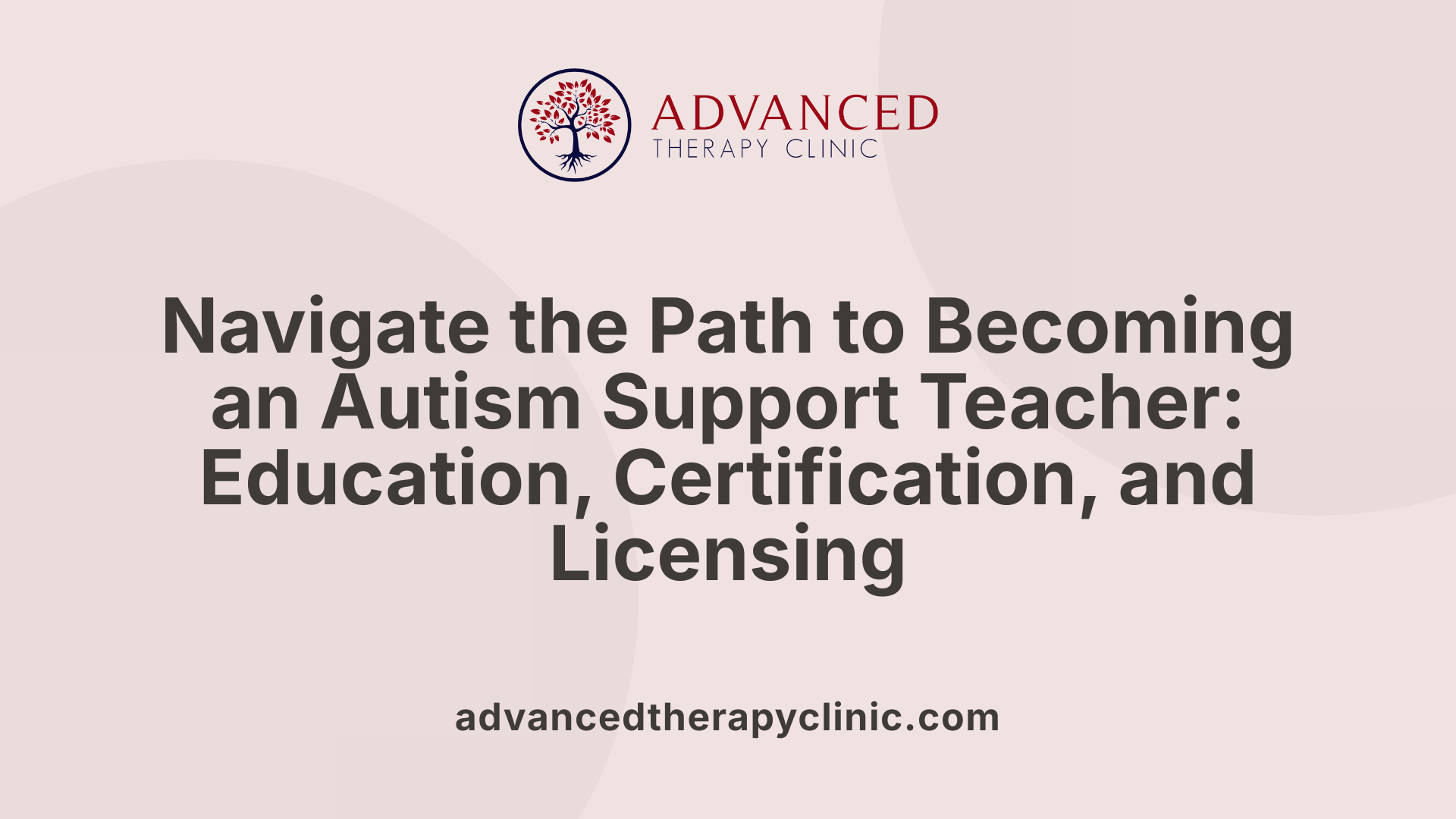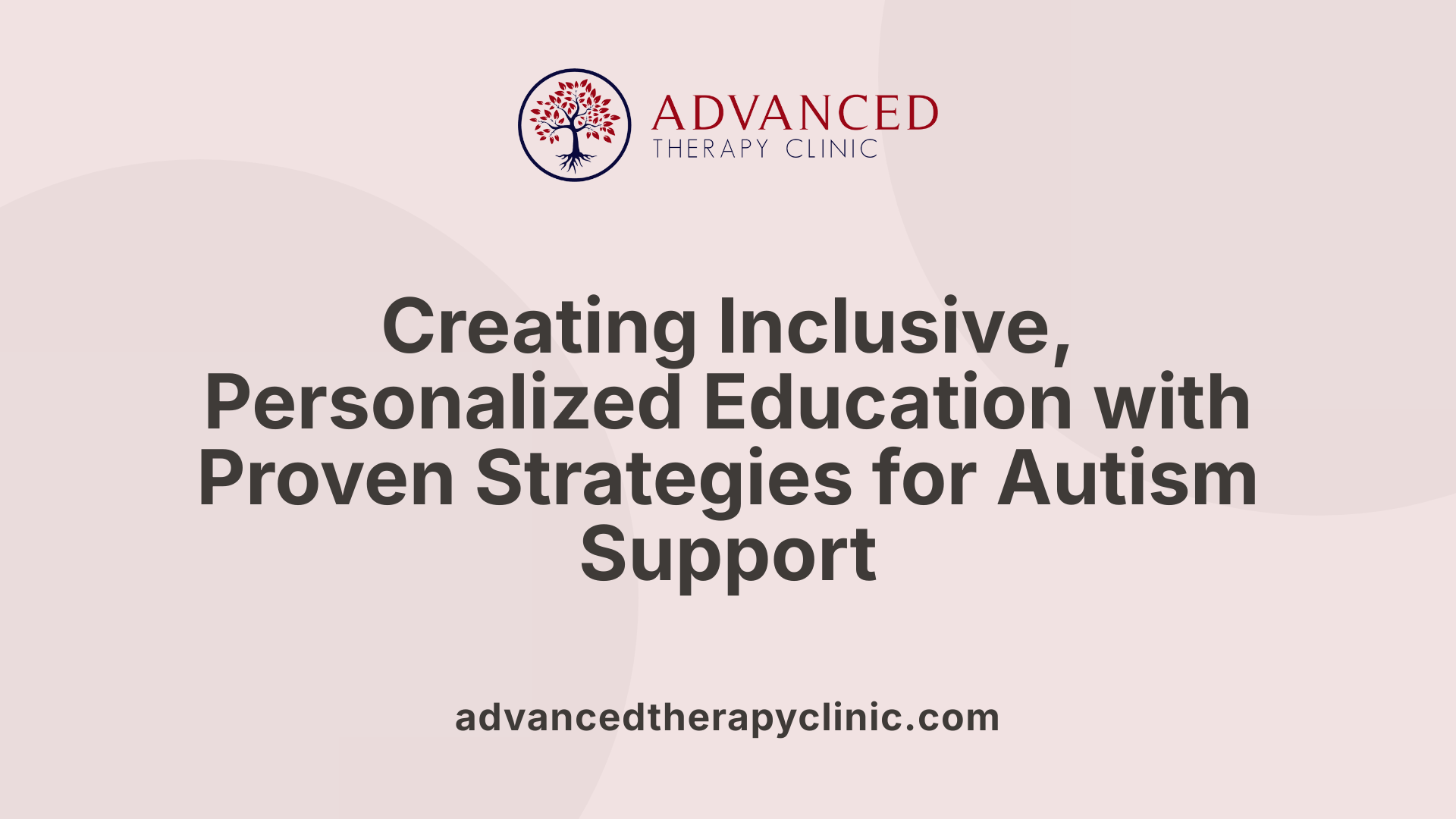How To Become an Autism Support Teacher


Understanding the Role of an Autism Support Teacher
Aspiring to become an autism support teacher requires a deep understanding of the specialized skills, educational pathways, and collaborative approaches needed to effectively support children on the autism spectrum. This article explores in detail the crucial steps, qualifications, and therapies related to this rewarding career, highlighting key competencies and the types of therapies involved, with a focus on applied behavior analysis (ABA) as a foundational approach.
Educational and Certification Pathways for Autism Support Teachers

What Are the Educational Requirements for Autism Support Teachers?
Autism support teachers typically start with a bachelor's degree in fields like psychology, sociology, education, or behavioral science. Continuing education with a master's degree is generally required to gain full professional qualification and to move toward certification.
How Does the Certification Process Work?
Certification involves completing between 1,500 to 2,000 hours of supervised field experience under a Board Certified Behavior Analyst (BCBA). The exact hour requirement can vary depending on state regulations. This hands-on training is essential for developing the competencies needed to effectively support autistic students.
What Role Does the BCBA Play?
A BCBA supervises the work of autism support teachers and therapists, guiding the application of Applied Behavior Analysis (ABA) techniques. They ensure that intervention plans are based on evidence and tailored to individual student needs, and often hold advanced degrees such as a master’s or doctorate in relevant fields.
Which Degree Programs Prepare Candidates for This Role?
Master’s degree programs, such as Drexel University’s MS in Applied Behavior Analysis, combine coursework with supervised fieldwork critical for BCBA certification. These programs equip students with the theory and practical skills necessary for effective autism support teaching.
What Are State Licensing Requirements?
Licensing typically requires BCBA certification alongside proof of continuing education. Renewal of licensure is commonly mandated every two years, ensuring that professionals stay current with evolving best practices and standards in autism education.
Overall, becoming an autism support teacher involves rigorous training, certification, and ongoing education to provide high-quality, evidence-based support.
Role and Responsibilities: What Does an Autism Support Teacher Do?

What Are the Day-to-Day Tasks of an Autism Support Teacher?
Autism support teachers play a vital role in helping students on the autism spectrum succeed in educational settings. Their daily duties often include offering direct instruction tailored to each student's needs, implementing structured teaching strategies like TEACCH, and providing visual supports to enhance understanding. They also monitor student progress and adjust learning plans as necessary, ensuring that education remains personalized and effective.
How Do Autism Support Teachers Collaborate with Therapists?
Collaboration is central to the autism support teacher's role. They frequently work alongside ABA therapists, occupational therapists, speech therapists, and physical therapists to provide comprehensive support. This teamwork allows for coordinating therapy goals, sharing observations, and integrating various strategies for consistent learning across all environments. Often, this collaboration occurs under the guidance of Board Certified Behavior Analysts (BCBAs) who oversee behavioral interventions.
What Support Strategies Are Commonly Used?
Support strategies focus on creating inclusive and adaptable learning environments. Autism support teachers employ sensory integration techniques and develop social skills through structured activities. They also incorporate play-based learning and emphasize communication development by using gestures, picture cues, and alternative communication methods tailored to individual needs.
How Is Behavior Assessed?
Behavioral assessment is an ongoing process that involves observing students to identify areas that require intervention. Autism support teachers may participate in Functional Behavior Assessments (FBAs) conducted by or in partnership with ABA therapists. These assessments help determine the function of behaviors, guiding the development of effective strategies to encourage positive behaviors and reduce challenges.
In What Ways Does the Teacher Facilitate Skill Acquisition?
Skill acquisition is addressed by breaking down complex behaviors into smaller, achievable steps and rewarding progress to reinforce learning. Autism support teachers design individualized learning plans focusing on essential life skills, communication, imitation, play, and safety. They continuously monitor and document progress, making data-driven decisions to refine instructional approaches and support sustained development.
Applied Behavior Analysis (ABA) Therapy: A Cornerstone of Autism Support Education
What Are the Principles of ABA Therapy?
ABA therapy is an evidence-based approach designed to improve behavioral and developmental outcomes. It focuses on breaking down complex behaviors into smaller, manageable steps to promote skill acquisition. Progress is reinforced through positive rewards, and data-driven methods are used to monitor improvements. ABA targets socially significant skills such as communication, daily living activities, imitation, play, and safety, adapting interventions based on ongoing assessments.
What Does an ABA Therapist Do?
An ABA therapist plays a crucial role by assessing individual behavioral challenges and implementing tailored intervention plans. They work closely with clients to teach new skills, reward progress, and adjust strategies as needed. Their responsibilities often include data collection, behavior monitoring, and collaborating with other professionals to ensure comprehensive care. Typically, ABA therapists operate under the supervision of a Board Certified Behavior Analyst (BCBA) who oversees treatment quality.
How Does ABA Help with Skill Development?
ABA therapy breaks behaviors into smaller parts, making skill acquisition more manageable. For example, a complex task like communicating a need might be divided into simpler steps such as making eye contact, vocalizing a sound, and using gestures. Therapists use positive reinforcement to encourage these behaviors, promoting gradual improvement. This structured, individualized approach helps children with autism and other developmental challenges develop critical life skills over time.
In What Settings Is ABA Therapy Provided?
ABA therapy is versatile and can be delivered in several settings to best serve individual needs. Common environments include schools, healthcare facilities, clinics, homes, and community spaces. Therapists often collaborate with educators, clinicians, and families to tailor therapy that supports inclusive learning and sustainable progress. This flexibility ensures that therapy integrates smoothly with daily life and educational activities, maximizing the benefit for children receiving support.
Collaborative Therapy Approaches in Schools: Integrating OT, PT, and Speech Therapy
How Do Occupational Therapy, Physical Therapy, and Speech Therapy Work Together in Schools?
In educational settings, children with autism benefit greatly from a collaborative approach that integrates occupational therapy (OT), physical therapy (PT), and speech therapy. These therapies target distinct but complementary areas of development, providing a holistic support system.
What Role Does Occupational Therapy Play?
Occupational therapists assist in improving motor skills, sensory processing, communication, and play abilities. They focus on everyday routines and natural environments to help children build practical skills essential for success in school and daily life.
How Does Physical Therapy Contribute?
Physical therapists support gross motor development by enhancing strength, mobility, and coordination. They help children achieve critical developmental milestones such as sitting, crawling, and walking, which are foundational for active participation in school activities.
What Is the Purpose of Speech Therapy?
Speech therapists assess and improve both verbal and nonverbal communication skills. This includes teaching the use of picture cues, gestures, and alternative communication systems to foster better social interaction and understanding.
How Is Teamwork Organized Among Specialists?
These professionals collaborate closely, often under the guidance of a Board Certified Behavior Analyst (BCBA), to craft individualized support plans. Through regular communication and shared goals, they ensure that interventions complement each other and address the child’s unique needs.
How Are Individualized Support Plans Developed?
Based on comprehensive assessments of a child’s strengths and challenges, therapy teams customize strategies to support learning and development within the school environment. Plans are continually adjusted to respond to progress and changing needs, emphasizing flexibility and inclusivity.
This integrated approach ensures that children receive well-rounded support, enhancing their educational outcomes and overall well-being in a supportive school setting.
Key Skills and Attributes for Effective Autism Support Teachers

What skills do autism support teachers need to succeed?
Autism support teachers require a blend of interpersonal and analytical skills to effectively support students on the autism spectrum. One crucial skill is active listening. It allows teachers to understand the unique needs and concerns of their students and families, ensuring that communication is clear and responsive.
Empathy is equally important. Teachers must genuinely connect with students' experiences, emotions, and challenges, which fosters trust and creates a supportive learning environment.
Adaptability is essential because students with autism have diverse and evolving needs. Teachers need to tailor their approaches and adjust strategies as students grow or as classroom dynamics shift.
Strong observation skills enable autism support teachers to notice subtle behaviors, progress, or difficulties. Careful observation informs decisions for individualized interventions and modifications.
Effective communication involves conveying ideas clearly and collaborating successfully with students, families, and multidisciplinary teams like therapists and clinicians. It also includes nonverbal communication that supports student understanding.
Lastly, critical thinking aids teachers in analyzing behavioral data and treatment outcomes, helping refine teaching techniques. It supports designing problem-solving strategies for behavioral or learning challenges.
Together, these skills form the foundation for autism support educators to create nurturing, inclusive, and effective learning settings.
Implementing Personalized and Inclusive Educational Strategies

What Are Some Effective Educational Strategies for Supporting Children with Autism?
Personalized and inclusive approaches are essential when supporting children on the autism spectrum in educational settings. Several strategies have proven effective in creating supportive, adaptable learning environments:
TEACCH (Treatment and Education of Autistic and related Communication-handicapped Children): This structured teaching approach emphasizes organizing the physical environment, using visual schedules, and breaking tasks into manageable steps tailored to the student's needs.
Structured Teaching: By clearly defining classroom routines and expectations, structured teaching helps students gain independence and predictability, which can reduce anxiety and improve focus.
Visual Supports: Tools such as picture cues, schedules, and visual timers help students understand tasks and transitions, making learning more accessible.
Sensory Integration Techniques: Many children with autism have sensory sensitivities; integrating sensory supports in the classroom—such as quiet zones or sensory breaks—can help regulate sensory input and promote comfort.
Social Skills Development: Intentional teaching of communication and social interaction skills is crucial. Group activities and peer interactions designed to foster social understanding are central to this approach.
Inclusive Education: Collaborating with specialists and ensuring students access general education classrooms promotes inclusion and peer engagement while accommodating individual needs.
How Is Therapy Customized Based on Individual Student Assessments?
Therapies and educational strategies are customized after careful assessment of each student's strengths and challenges. Ongoing adjustments ensure that supports evolve with the student's changing needs. This personalized approach maximizes engagement and learning outcomes, making the educational experience more effective and supportive.
These educational strategies work best when integrated into a coherent program, supported by trained professionals and involving collaboration among educators, therapists, families, and specialists.
Starting the Journey: From Autism Diagnosis to School-Based Support

Early Diagnosis and Screening
Early identification of autism spectrum disorder (ASD) can be made reliably by age 2, with some screenings detecting signs as early as six months. The Centers for Disease Control and Prevention (CDC) recommends routine developmental screenings to monitor early signs.
Assessment Processes
Following a diagnosis, a comprehensive Functional Behavior Assessment (FBA) is conducted. This helps identify specific behavioral challenges and skill deficits, forming the foundation for individualized therapy plans.
Insurance and Funding
Families seeking ABA therapy often work with insurance providers including Medicaid, Medicare, or private insurance to secure coverage. Authorization must be obtained when therapy is deemed medically necessary. This financial support is vital for accessing qualified providers.
Initial Therapy Planning
Once assessments and funding are in place, initial ABA therapy sessions begin under the supervision of certified professionals. Treatment goals are developed collaboratively, focusing on skill acquisition, behavior reduction, and parent training.
School-Based Support
In educational settings, ABA therapy is tailored to support children on the autism spectrum within inclusive classrooms. Strategies such as TEACCH, visual supports, and social skills development ensure that children receive adaptable and personalized learning experiences.
Becoming an Effective Autism Support Teacher: A Lifelong Commitment
The path to becoming an autism support teacher is multifaceted, integrating rigorous education, certification, and hands-on experience with compassionate collaboration and personalized teaching strategies. Understanding the scientific foundations of ABA therapy and other complementary therapies, acquiring essential skills, and fostering inclusive learning environments are pivotal. This career demands dedication to continual learning and adaptation to meet the evolving needs of students with autism. Ultimately, autism support teachers play a vital role in enabling children to thrive academically, socially, and developmentally within supportive school settings.
References
Recent articles

What Is Hypermobility Spectrum Disorder
Understanding Hypermobility Spectrum Disorder: Insights and Management

How Behavior Analysis Helps with Teaching Flexibility in Problem-Solving
Harnessing Behavior Analysis to Enhance Adaptive Problem-Solving Skills

Autism And Deafness
Bridging the Gap: Understanding Autism and Deafness

Does Autism Cause Hyperactivity
Unraveling the Connections Between Autism and Hyperactivity

Sensory Overload Autism Examples
Understanding Sensory Overload in Autism: Examples and Insights

Autism and Addiction's Close Connection
Unraveling the Complex Relationship Between Autism and Substance Use Disorders


